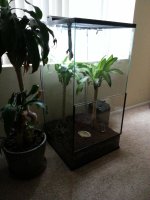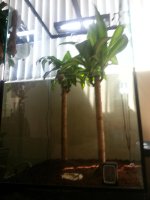Fumbles
New member
I was going to add to a vivarium thread I had going but I decided this is a more general question.
I was going to buy a large piece of grapewood that is sufficient enough to supply all vertical and horizontal surfaces. However, I noticed the surface of it is rough. Fimbriatus have very strong satae and much more surface area on their feet than any other uroplatus, maybe even any other gecko. Mine get "hung up" on non-smooth surfaces as if all rough or woven surfaces were made of velcro. I can clearly see his difficulty - it's as if he has gum all over the bottom of his feet. He'll get caught on my shirt if he jumps and he'll also avoid the Exo Terra fake bendable vines, I assume, because of their very rough texture.
I'm wondering if:
-Grapewood is a good idea in the vivarium given its rough texture compared to driftwood or dracaena - would he have a tough time walking on it? Has anyone used it? He'll totally avoid it if he has any difficulty.
-Anyone has noticed the fimbriatus have extremely strong satae and surfaces such as carpet and cotton should be avoided?
I was going to buy a large piece of grapewood that is sufficient enough to supply all vertical and horizontal surfaces. However, I noticed the surface of it is rough. Fimbriatus have very strong satae and much more surface area on their feet than any other uroplatus, maybe even any other gecko. Mine get "hung up" on non-smooth surfaces as if all rough or woven surfaces were made of velcro. I can clearly see his difficulty - it's as if he has gum all over the bottom of his feet. He'll get caught on my shirt if he jumps and he'll also avoid the Exo Terra fake bendable vines, I assume, because of their very rough texture.
I'm wondering if:
-Grapewood is a good idea in the vivarium given its rough texture compared to driftwood or dracaena - would he have a tough time walking on it? Has anyone used it? He'll totally avoid it if he has any difficulty.
-Anyone has noticed the fimbriatus have extremely strong satae and surfaces such as carpet and cotton should be avoided?



